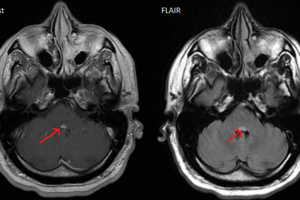Retinal detachment is a situation where the inner layers of the retina separate from the from the underlying retinal pigment epithelium. This epithelium is called the choroid and is a vascular membrane containing large branched pigment cells sandwiched between the retina and sclera.
Of the 3 types of retinal detachment, the first, also called rhegmatogenous RD, is the most common. In this circumstance, vitreous fluid flows through the hole in the neuronal layer and creates the detachment.
Tractional retinal detachments occur when there are adhesions between the vitreous gel and the retina, and centripetal mechanical forces separate the retina from the RPE. There is not, however, a retinal break. The most common causes of tractional RD are a proliferative diabetic retinopathy, sickle cell disease, advanced retinopathy of prematurity and penetrating trauma.
Vitreoretinal traction increases with age. This is caused by a shrinkage and collapse of the vitreous gel. This occurs in approximately two thirds of persons older than 70. Most of the 6% of the total population who have retinal tears have only benign atrophic holes, without accompanying pathology. These do not lead to retinal detachment.
Patients with high myopia aphakia, i.e., cataract removal without lens implant, and cataract extraction complicated by vitreous loss during surgery have an increased detachment rate.
When evaluating a patient with a possible retinal detachment, history should be directed towards the nature of vision loss, any history of sudden, recent floaters or flashing lights, any loss of peripheral visual fields, any family members with loss of vision or history of retinal disease, and any history of trauma.
National guidelines also call for an ocular exam that includes best corrected visual acuity, pupillary responses, biomicroscopy, binocular indirect ophthalmoscopy, with scleral indentation if indicated, tonometry, visual field screening (confrontation), retinal drawing or photodocumentation, if indicated.
Treatment as defined by guidelines includes restriction of physical activity and reduction in eye movement. Once a diagnosis of symptomatic retinal detachment has been made, immediate referral to a retina specialist for surgery should be made because without surgery blindness will ensue.
The options for surgery include laser, pneumatic retinopexy, scleral buckle, and vitrectomy. Laser and cryopexy are means of simply “closing the hole” and can be used early on.
Pneumatic retinopexy can be used to treat retinal detachment if the tear is small and easy to close. The procedure consists of injecting a small gas bubble into the vitreous. The bubble then rises and presses against the retina, closing the tear. Then, laser or cryopexy is used to formally seal the hole. The procedure is 85% successful.
A scleral buckle involves placing a silicone band round the eye to hold the retina in place. Here too, thermal treatment may then be necessary to close the tear. This procedure is effective as high as 95% of the time.
Vitrectomies are used for large tears. The vitreous is removed from the eye and replaced with a saline solution.


